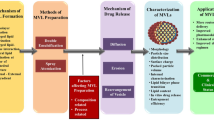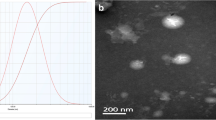Abstract
The purpose of the present study was to prepare multivesicular liposomes with a high drug loading capacity and to investigate its potential applicability in the oral delivery of a peptide, human epidermal growth factor (rhEGF). The multivesicular liposomes containing rhEGF was prepared by a two-step water-in-oil-in-water double emulsification process. The loading efficiency was increased as rhEGF concentration increased from 1 to 5 mg/mL, reaching approximately 60% at 5 mg/mL. Approximately 47% and 35% of rhEGF was released from the multivesicular liposomes within 6 h in simulated intra-gastric fluid (pH 1.2) and intra-intestinal fluid (pH 7.4), respectively. rhEGF-loaded multivesicular liposomes markedly suppressed the enzymatic degradation of the peptide in an incubation with the Caco-2 cell homogenate. However, the transport of rhEGF from the multivesicular liposomes to the basolateral side of Caco-2 cells was two times lower than that of the rhEGF in aqueous solution. The gastric ulcer healing effect of rhEGF-loaded multivesicular liposomes was significantly enhanced compared with that of rhEGF in aqueous solution; the healing effect of the liposomes was comparable to that of the cimetidine in rats. Collectively, these results indicate that rhEGF-loaded multivesicular liposomes may be used as a new strategy for the development of an oral delivery system in the treatment of peptic ulcer diseases.
Similar content being viewed by others
References
Anderson, K. E., Stevenson, B. R., and Rogers, J. A., Folic acid-PEO-labeled liposomes to improve gastrointestinal absorption of encapsulated agents.J. Control. Release, 60, 189–198 (1999).
Annaert, P., Kinget, R., Naesens, L., Clercq, E. D., and Augustijins, P., Transport, uptake and metabolism of the bis(pivaloyloxymethyl)-ester prodrug of 9-(2-phosphonyl-methoxyethyl) adenine in anin vitro cell culture system of the intestinal mucosa (Caco-2).Pharm. Res., 14, 492–496 (1997).
Aramaki, Y., Tomizawa, H., Hara, T., Yachi, K., Kikuchi, H., and Tsuchiya, S., Stability of liposomesin vitro and their uptake by rat Peyer’s patches following oral administration.Pharm. Res., 10, 1228–1231 (1993).
Carpenter, G. and Cohen, S., Epidermal growth factor (EGF).Annu. Rev. Biochem., 48, 193–216 (1979).
Chen, H., Torchilin, V., and Langer, R., Polymerized liposomes as potential oral vaccine carriers: Stability and bioavailarbility.J. Control. Release, 42, 263–272 (1996).
Elder, J. B., Ganguli, P. C., Gillespie, I. E., Gerring, E. L., and Gregory, H., Effect of urogastrone on gastrin levels in normal subjects.Gut, 16, 887–893 (1975).
Florence, A. T., The oral absorption of micro- and nanoparticulates: Neither exceptional nor unusual.Pharm. Res., 14, 259–266 (1997).
Gregory, H., Isolation and structure of urogastrone and its relationship to EGF.Nature, 257, 325–327 (1975).
Han, K., Lee, S. J., Kim, J. W., and Chung, Y. B., Oral bioadhesive gels of rhEGF for the healing of gastric ulcers.J. Kor. Pharm. Sci., 28, 99–107 (1998).
Iwanaga, K., Ono, S., Narioka, K., Morimoto, K., Kakemi, M., Yamashita, S., Nango, M., and Oku, N., Oral delivery of insulin by using surface coating liposomes improvement of stability of insulin in GI tract.Int. J. Pharm., 157, 73–80 (1997).
Katre, N. V., Asherman, J., Scahefer, H., and Hora, M., Multivesicular liposome (DepoFoam™) technology for the sustained delivery of insulin-like growth factor-I (IGF-I).J. Pharm. Sci., 87, 1341–1346 (1998).
Kim, S., Turker, M. S., Chi, E. Y., Sela, S., and Martin, G. M., Preparation of multivesicular liposomes.Biochim. Biophys. Acta, 728, 339–348 (1983).
Kirkegaard, P., Olsen, P. S., Poulsen, S. S., and Nexo, E. Epidermal growth factor inhibits cysteamine-induced duodenal ulcer.Gestroenterology, 85, 1277–1283 (1983).
Konturek, S. J., Radecki, T., and Brzozowski, T., Gastric cytoprotection by epidermal growth factor.Gestroenterology, 81, 438–443 (1981).
Li, H., Chung, S. J., Kim, D. C., Kim, H. S., Lee, J. W., and Shim, C. K., The transport of a reversible proton pump antabonist, 5,6-dimethyl-2-(4-fluorophenylamino)-4-(1-methyl-1,2,3,4-tetrahydroisoquinoline-2-yl) pyrimidine hydrochloride (YH1885), across Caco-2 cell monolayers.Drug Metab. Dispos., 29, 54–59 (2001).
Li, H., Song, J. H., Park, J. S., Han, K., Polyethylene glycolcoated liposoems for oral delivery of recombinant human epidermal growth factor.I. J. Pharm., 258, 11–19 (2003).
Mantripragada, S., A lipid based depot (DepoFoam® technology) for sustained release drug delivery.Prog. Lipid Res., 41, 392–406 (2002).
Murry, D. J. and Blaney, S. M., Clinical pharmacology of encapsulated sustained-release cytarabine.Ann. Pharmacother., 34, 1173–1178 (2000).
Russell-Jones, G. J., The potential use of receptor-mediated endocytosis for oral delivery.Adv. Drug Del. Rev., 20, 83–97 (1996).
Senderoff, R. I., Wootton, S. C., Boctor, A. M., Chen, T. M., Giordani, A. B., Julian, T. N., Radebaugh, G. W., Aqueous stability of human epidermal growth factor.Pharm. Res., 11, 1–48 (1994).
Ye, Q., Asherman, J., Stevenson, M., Brownson, E., Katre, N. V., DepoFoam™ technology: a vehicle for controlled delivery of protein and peptide drugs.J. Control. Release, 64, 155–166 (2000).
Author information
Authors and Affiliations
Corresponding author
Rights and permissions
About this article
Cite this article
Li, H., An, J.H., Park, JS. et al. Multivesicular liposomes for oral delivery of recombinant human epidermal growth factor. Arch Pharm Res 28, 988–994 (2005). https://doi.org/10.1007/BF02973888
Received:
Issue Date:
DOI: https://doi.org/10.1007/BF02973888




